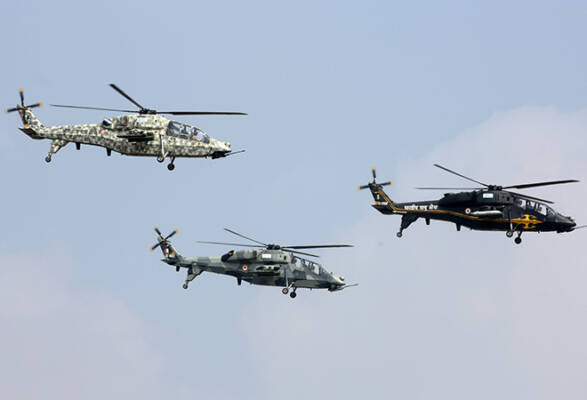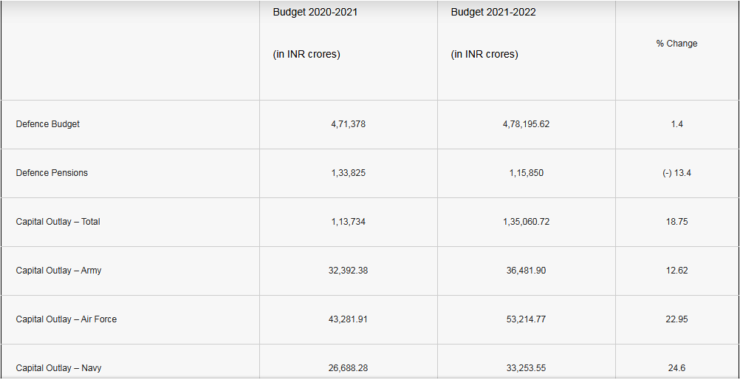
Even as Finance Minister, Nirmala Sitharaman, unveiled India’s Union Budget for the financial year (FY) 2021-2022 in Parliament on February 1, there was no statement on the allocation of the defence budget, the absence of which was prominently noticeable. A thorough review of it is thus merited.
At INR 4,78,195.62 crores, the Ministry of Defence’s budget estimate for FY 2021-2022 rose by a nominal 1.4 per cent; though in light of the pandemic-induced economic downturn and healthcare expenditure, emergency defence procurement amounting to INR 20,776 crores that India has had to make in the face of an increasingly belligerent and assertive China, and the absence of any increase in taxes or the imposition of a COVID cess, even such a bare increase should not be judged too harshly. On the contrary, defence spending stands at 13.7 per cent of the total budget and incorporates many noteworthy changes that indicate a much-needed course correction towards a more efficient use of finances. While the budget allocated to defence pensions has reduced by 13.4 per cent, capital outlay on defence services, i.e., funds used to buy new equipment and aid the military’s modernization, has increased by 18.75 per cent.

The defence budget’s focus, hence, seems to invariably be on modernisation. Significant increases in the Air Force and the Navy’s capital outlays especially highlight this. Moreover, by planning to spend more on new heavy and medium vehicles for the Army; aircraft, aeroengines and naval fleet for the Navy; and land for the Air Force; the government has set its priorities on how it wants to use the limited resources at its disposal to shore up and augment the country’s military strength. Significant allocation for the purchase of missiles, air defence systems, and arms and ammunition, among others, have also been made under the designation of “other equipment.” Undoubtedly, the ongoing border dispute with China, and the challenges of a two-front theatre has influenced these allotments.
There is, still, only so much one can take away from reading the budget estimates. For a broader image of where the Indian Military’s modernisation and procurement efforts are headed, we must look at the spate of defence reforms that have recently been introduced. Chief among them is the call for Atmanirbharta (self-reliance) and Make in India. To encourage this and assist the indigenous defence manufacturing sector to stand on its feet, the government in August 2020 created a “negative list” that restricts the import of 101 weapons and military systems in a phased manner. The list includes assault rifles, light machine guns, sniper rifles, land variant of short-range surface-to-air missiles, shipborne cruise missiles, bullet-proof jackets, ballistic helmets, ultralight howitzers, light combat aircraft, and light combat helicopters.
Additionally, the Ministry of Defence has bifurcated the capital procurement budget for FY 2020-2021 between domestic and foreign purchase routes, earmarking INR 52,000 crores for the domestic sector. Greater emphasis has also been placed on higher indigenous content in new purchases in the Defence Acquisition Procedure (DAP) 2020. Other steps taken by the government to make India more independent in matters of defence production and even transition to a defence exporter include the bid to privatise the Ordnance Factory Board (OFB), and an increase in the limit on foreign direct investment (FDI) in the defence sector through the automatic route from 49 per cent to 74 per cent.
Apart from better utilisation of finances, the defence establishment has also embarked on improving the efficiency of its present and future assets by reforming the structure of the military into integrated theater commands, including the formation of joint logistics nodes that will handle ammunition, rations, fuels, oils and lubricants, civil-hired transport, aviation clothing, spares and engineering support for the tri-services. Another goal of the integration is recalibrating manpower, especially in the Army that is going to spend a massive INR 93,749.57 crores on pay and allowances. Like other major militaries around the world who have reduced manpower to transform themselves into a leaner, more efficient and lethal, and technologically integrated force, India too has recognised the financial and operational necessity to do so.
Nevertheless, there is still tremendous potential for greater resource optimisation. As the revised estimates of the FY 2020-2021 defence expenditure show, INR 20,776 crores was spent on emergency procurements after hostilities and military buildup increased on the India-China border. While China’s unprecedented acts of aggression could not have been forecasted, its relentless posturing, continued infrastructure development well inside India’s perception of the Line of Actual Control (LAC), and vast differences in capabilities favoring the Chinese military should give the Government of India more than sufficient cause for concern and the formulation of an effective and comprehensive national security strategy to counter China should be prioritised. Buying expensive defence systems on an emergency basis not only costs more, but in the absence of a viable domestic market, results in the outflow of foreign reserves and hampers efforts toward atmanirbharta.
Moreover, India’s national security strategy should embrace new technologies with next generation warfare capabilities. Research, development, and use of swarm drones should be encouraged due to their cost-effectiveness and high-cost penalty on enemy air defence systems and conventional military assets. So far, India’s efforts, as showcased in the Army Day Parade 2021, and at the Aero India 2021 event, are promising. These systems should now be enhanced to include technologies that can initiate as well as counter an adversary’s electronic warfare capabilities and evade short-range air defence systems, thereby, making them battle-ready and a lethal force multiplier. The government can use a greater portion of its research and development funds, a substantial part of which was left unutilised in the current FY, to augment these efforts and fast-track production.
Likewise, more efficient concepts of acquisition, like taking into account a system’s life-cycle costs instead of simply choosing the lowest bidder, should be adopted and made standard practice. Doing so would give decision-makers a chance to holistically evaluate weapons systems, taking into account their long-term resource requirements, life span, and cost incurred per capability.
Of great significance is a recommendation by the 15th Finance Commission as well. To better meet the challenge of modernising the armed forces, the Commission has suggested that a dedicated, non-lapsable “Modernisation Fund for Defence and Internal Security (MFDIS)” be constituted by the Union Government to the tune of INR 2.38 lakh crores over the period 2021-2026. This special funding mechanism, proposed to be named the “Rashtriya Suraksha Naivedyam Kosh,” would be used to make capital investments for the modernisation of defence services, Central Armed Police Forces (CAPFs), and state police forces. A part of the fund could also be used for the welfare of personnel. Notably, this fund would supplement the annual budget allocations and not replace or be a part of it. If created, the fund would bolster the purchasing power of the forces and help reduce the wide gap between the technological capabilities of India and its adversary.
The budget estimate unveiled this week, therefore, provides a window through which one can see both, the government’s resolve to modernise the hitherto neglected and red-tape-hindered military, and their constraint of proportioning a finite and stressed budget. Even though it is certainly more desirable to have more financial resources at one’s disposal, ingenuity, innovation, talent and capability are equally, if not more important. That, in essence, is what Indian defence policy must strive to achieve.
-The article was originally published on Observer Research Foundation portal https://www.orfonline.org/expert-speak/indias-defence-budgeting-strives-to-chart-a-new-course/?amp
-The author is director of research at Observer Research Foundation (ORF), New Delhi, and Professor of international relations at King’s College London and the co-author is a Research Intern at ORF. The views expressed are of the author(s) and do not necessarily reflect the views of Raksha Anirveda








